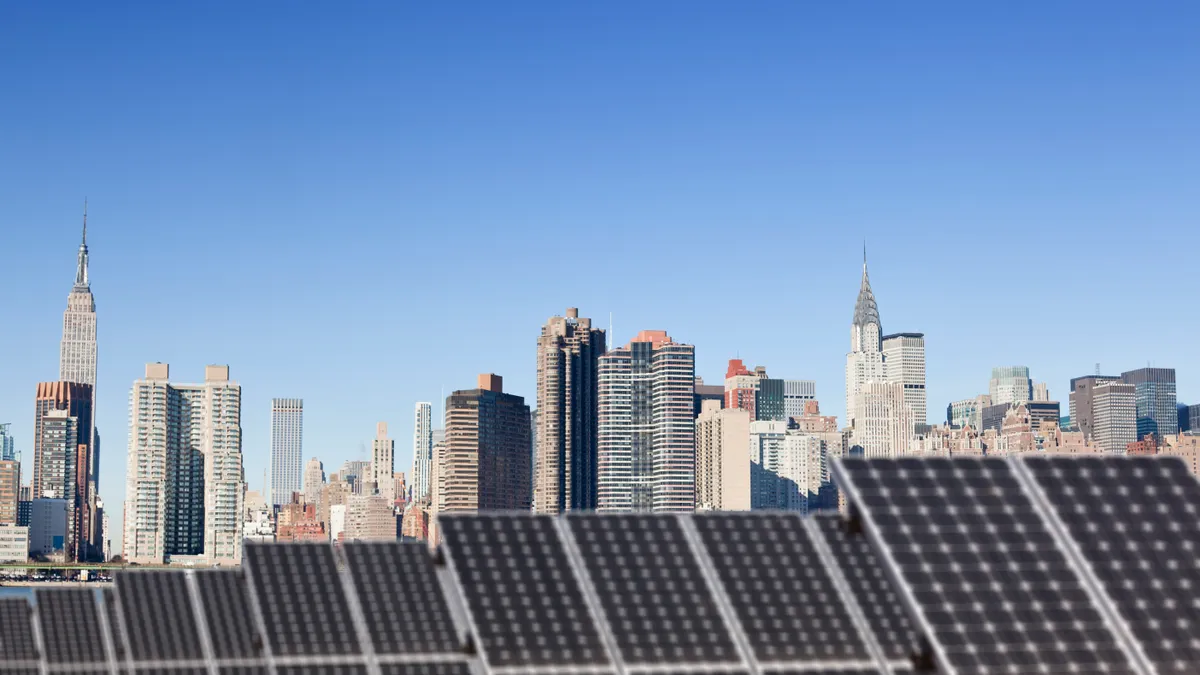Dive Brief:
- New York must support the development and deployment of dispatchable, carbon-free energy resources while continuing to build out the state’s renewable energy grid, New York Gov. Kathy Hochul, D, said last week at the conclusion of a state clean energy conference.
- Insights gained during the New York State Energy Research and Development Authority Future Energy Economy Summit, held Sept. 4-5 in Syracuse, will inform state renewable energy deployment goals, interconnection reforms and permitting enhancements; encourage action on advanced technologies critical to meeting the state’s carbon-free power generation target by 2040; help the state understand the potential role of advanced nuclear in its power sector; and maximize relevant federal funding opportunities, Hochul said.
- “These next steps align with investments and priorities we are seeing at the federal level, which makes [them] critical to successfully leveraging future funding opportunities to continue our progress,” NYSERDA President and CEO Doreen Harris said in a statement.
Dive Insight:
New York has taken ambitious steps to reduce and eventually eliminate carbon emissions from power generation by 2040. Earlier this year, New York utility regulators adopted a road map to deploy 6 GW of energy storage resources — about 20% of the state’s peak load — by 2030, doubling a 3-GW target set in 2018.
Longer-duration energy storage is an important component of the road map and New York’s broader decarbonization goals. The road map aims for storage resources with durations of eight hours or more to comprise at least 20% of each bulk storage procurement, and NYSERDA in June announced a $5 million competitive solicitation process for resources with durations of 10 hours or more.
The state may need more than 4 GW of 8-hour storage by 2035 and nearly 7 GW by 2050, according to the road map.
New York must also triple its renewable energy generation capacity within eight years to meet its target of 70% of electricity from renewable resources by 2030, New York Comptroller Thomas DiNapoli said in an Aug. 2023 report.
An Aug. 16 draft report by the grid operator in neighboring New England envisioned significantly higher costs for a grid decarbonization strategy dominated by wind, solar and storage. The six-state region would need 97 GW of new wind, solar and battery capacity by 2050 in a renewables-dominated scenario, ISO New England said.
A decarbonization strategy that paired 15.1 GW of small modular reactors with renewables would require 57% less renewable capacity, while a strategy that paired around 20 GW of synthetic natural gas-capable generating units with renewables would need 37% less wind, solar and storage capacity, according to the report.
The SMR scenario’s capital costs are 33% lower than the renewables-dominated base case, ISO-NE said.
The grid operator’s analysis underscores the value of clean, dispatchable generating capacity in a deeply decarbonized future, said Patrick White, research director at the Nuclear Innovation Alliance.
“[ISO-NE] came to the conclusion that to reach net-zero goals, you have to build out more renewables at higher cost if you exclude nuclear [or other clean, firm] technology,” White said. “We thought that was going to be true in many markets, but this independent analysis puts region-specific numbers on the potential avoided capacity.”
New York’s need for decarbonized firm generation resources could exceed 40 GW by 2040, according to the New York Independent System Operator’s 2023-2042 System & Resource Outlook.
NYSERDA’s Draft Blueprint for Consideration of Advanced Nuclear Technologies, discussed in detail at the Future Energy Economy Summit by state policymakers and industry stakeholders including Nuclear Innovation Alliance Executive Director Judi Greenwald, cites the “scalability, economic development, low land use, and potential applications of process heat” as advantages of advanced nuclear deployment in New York.
With 32 nuclear companies already located in New York and the potential for nuclear plants sited at retired fossil generating stations to create dozens or hundreds of new jobs, the economic development benefits are particularly attractive, NYSERDA said in the blueprint.
But technological readiness, safety and security considerations, siting challenges, supply chain and workforce needs, waste generation and disposal, and project financing all need to be discussed as part of the state’s advanced nuclear strategy, NYSERDA said.
NYSERDA is seeking industry feedback on the draft advanced nuclear blueprint now and will finalize it by the end of the year, Hochul said.













